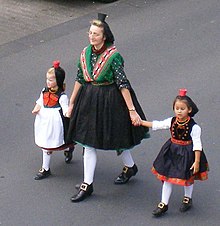Schwalm costume
The Schwalm costume has been worn in the Schwalm for around 150 years . The men wore a blue smock and dark breeches on weekdays, white breeches on Sundays, a black church skirt and three-masters . The women wore up to fifteen more skirts, one on top of the other, with colored tape trimmings under a pleated black skirt with ribbon trimmings, depending on their wealth. White shirt sleeves peeked out from the tight-fitting bodice. The brightly decorated Betzel (bonnet) was worn on Sundays on the top of the head tied hair bun ( Schnatz ); a blue tulle hood was put over it during the evening meal. The bride wore a heavy tinsel headdress (she was scrambled ) and the board , a shoulder hanging made of colored ribbons, with gold embroidered breast ribbons and corners on the hips. Lust adorned the groom's hat , a headdress made of colored glass balls and tinsel. The size, care and lushness of the equipment also reflected the wearer's financial situation. Some pieces of costume were reserved for rich and privileged farming families.
The colors in which the costume was kept were also important. For men, the vests and for women all ribbons and decorations were different depending on age and family situation. The single wore red as a sign of youth and the unmarried. From the wedding on, women wore green and men wore blue vests. After the confirmation of the last child, the Schwalm women mostly wore blue or purple and in old age black. These rules were very strict and had to be followed by everyone. The mourning robe used to be part of the mourning costume. There were small deviations in every village in the Schwalm.
The colorful variety of costumes in the Schwalm attracted many painters to study them or to bring them to life, such as B. the artists of the Willingshausen painters colony , u. a. Carl Bantzer or Paul Scheffer .
Today, many traditional costume groups maintain the old customs and there are also some old women who still wear the Schwalm traditional costume today.
On October 18, 2008, the German Trachtenverband awarded the Schwalm costume the title “Tracht des Jahres 2009”. It was crucial that the costume is still cultivated today, that knowledge of the tradition is preserved and that it is a lively costume that is still worn on various occasions. For one year, the traditional costume should represent all traditional costumes in Germany and represent the traditional costumes on certain occasions.
It is often assumed that the fairy tale character Little Red Riding Hood is named after the red Betzel of the Schwalm costume. However, the fairy tale is older than the traditional costume and does not originate in the Schwalm.
supporting documents
Brockhaus encyclopedia in 24 vol., 19th completely revised. Ed., Vol. 10. Herr - Is., P. 42, 1989

